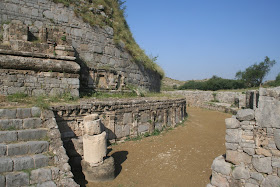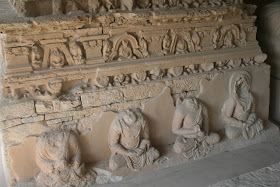 Before I ever saw it, the posters of Yacub Al Mansour's 1195 C.E. mosque in Morocco's capital Rabat intrigued me: 200 pillars of dusty sandstone cast shadows of precision (a testament to early Islamic mathematicians and architects) in the ruined mosque which is overshadowed by Le Tour Hassan (Hassan Tower). Hassan Tower (44m) was intended to be the largest minaret in the world when it was built -- 80m, but it was never finished, and the adjacent mosque, also never completely finished, was destroyed by an earthquake in 1755. Similar to the Giralda in Seville, which was designed by the same architect Jabir, the inside of the minaret is ascended by ramps instead of stairs, allowing the king to ride his horse up. Al Mansour also built (and Jabir also designed) the Koutobia mosque in Marrakech (#988), which is a similar style, but Rabat's mosque's construction stalled after the king's death.
Before I ever saw it, the posters of Yacub Al Mansour's 1195 C.E. mosque in Morocco's capital Rabat intrigued me: 200 pillars of dusty sandstone cast shadows of precision (a testament to early Islamic mathematicians and architects) in the ruined mosque which is overshadowed by Le Tour Hassan (Hassan Tower). Hassan Tower (44m) was intended to be the largest minaret in the world when it was built -- 80m, but it was never finished, and the adjacent mosque, also never completely finished, was destroyed by an earthquake in 1755. Similar to the Giralda in Seville, which was designed by the same architect Jabir, the inside of the minaret is ascended by ramps instead of stairs, allowing the king to ride his horse up. Al Mansour also built (and Jabir also designed) the Koutobia mosque in Marrakech (#988), which is a similar style, but Rabat's mosque's construction stalled after the king's death.
Overlooking the Oud Bou Regreg (river/inlet) and the twin city of Salé, the Al Mansour esplanade is a prime location very close to the center of the city. It is also the site of the Mausoleum to the current king Mohamed VI's grandfather (Mohamed V) and father (Hassan II). They are laid to rest in richly decorated green-roofed below-ground tomb, and visitors can enter the open chamber from above. A Koran reader is often present, and the complex is guarded by smartly-dressed soldiers both on horseback and standing at attention.
Source: Lonely Planet Morocco, 6th Edition
















































